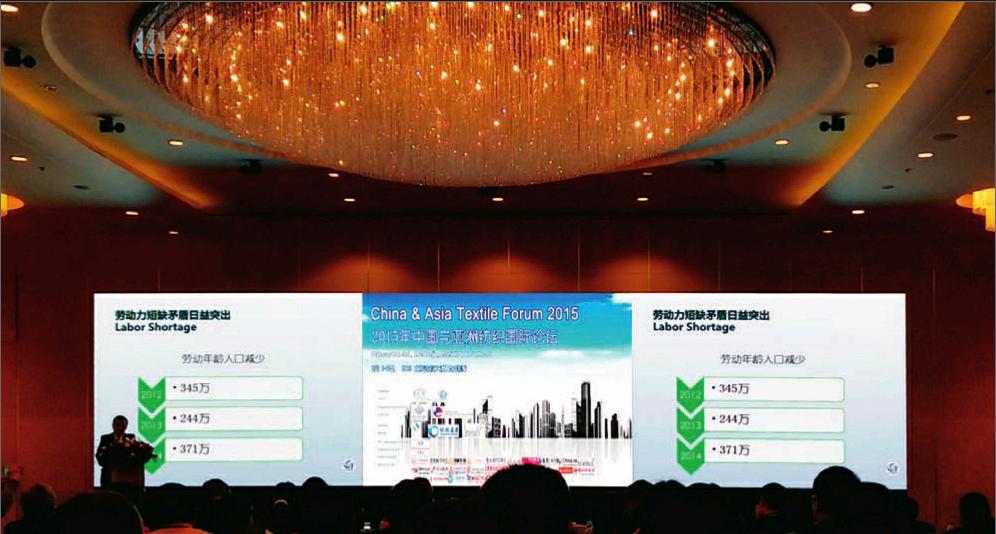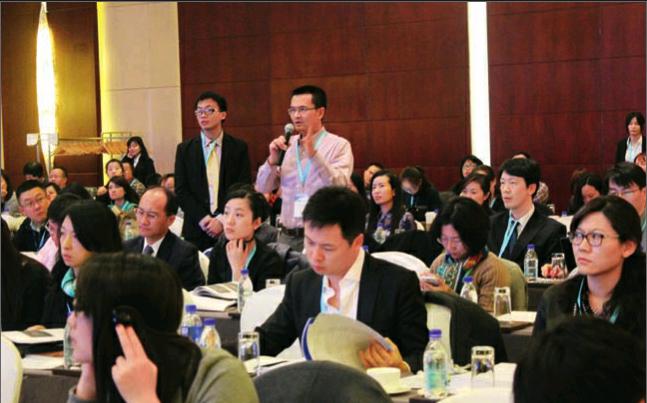China’s textile industry under new normal towards a powerful nation
By+Zheng+Ran


OOn February 2nd, Mr. Li Jincai, President of China Textile Planning Research Association presented a speech to introduce Chinas textile industry under new normal during China & Asia Textile Forum 2015.
Basic situation of textile industry in China
The status of the textile industry can be viewed as three parts, namely traditional pillar industries, important livelihood, and industry with obvious international competitive advantage. According to the Figures 1 to 4, it is obvious that within the industry, its comprehensive strength and international influence is constantly growing.
Besides, industry development plays a key role in acceleration of employment, incoming increase and construction of urbanization.
Transformation development of textile industry since the implementation of the “12th Five-Year Plan”
Since the implementation of the “12th Five- Year Plan”, the growth of main indexes saw relatively significant slowdown. For average annual rate of revenue of textile enterprises above designated size, the percentage between January to November, 2014 was 7.33, down 12.27 percent comparing with the numbers of average in 10th Five Year Plan; with regard to average annual rate of export value of Chinas textile and apparel, the average in 10th Five Year Plan decreased from 17.2 percent to 5.19 percent on yearon- year basis in 2014. While for the general trade of export of textile and apparel, the ratio change of January to November, 2014 gained 76.1 percent, up 11.9 percent than average one of the 10th Five Year Plan. And it shows that textile industry attains positive progress in structural adjustment while the quality and benefi ts of industry operation is further improved. Meanwhile, the enhancement of global resource allocation in textile industry, as well as continuous enhancement of international operational competency pushes regional structure adjustment progress steadily.
Main situations for development of textile industry
New pattern of global industry factors:
·Further layout adjustment of global industry factors;
·Greater dual competitive pressure for Chinas textile industry;
·Strategy of reindustrialization in developed countries;
·Predominance and powerful posi-tion of high end sector of global value chain by developed countries;
·Areas and regions in Southeast Asia and South Asia are now becoming vigorous competitors for traditional advantage of Chinas textile industry;
·Deeper promotion of global and regional economic and trade cooperation.
New power in consumer market:
·Stable growth of market demand at home and abroad; however, profound changes are taking place in pattern and structure of consumption;
·Slowdown of growth for trade of international textile and apparel; however, the general situation is with certain growth;
·Expansion of domestic demand and consumption upgrade will become the greatest motivation for industry development;
·Development of industrial textiles with strong momentum;
·Development of cross-border and domestic electronic commerce at top speed.
New revolution in information era:
·Internet economy profoundly infl uences the mode of traditional industries and consumption mode;
·Reconstruction of business chain and creations of new production organize ways among enterprises;
·Demands-oriented manufacturing mode;
·Supplementary and substitution effect by electronic commerce is constantly intensified against traditional marketing channel of textile and apparel.
New strategy for regional economy:
·Promotion of more open and collaborative adjustment of industry layout;
·Development of western regions, revitalization of the northeast China, rise of central China and take the lead in Eastern China;
·Three major strategies, namely“One Belt and One Road”, synergetic development in Beijing, Hebei & Tianjin and Yangtze River Economic Zone;
·Acceleration of implementation of employment plan via development of textile and apparel industry in Xinjiang.
New height of ecological civilization:
·Response to climate change and construction of ecological civilization are basic liabilities for the development of the industry;
·The influence of ecological environment in decision of development is constantly increased in all countries; environmental protection technology is now becoming an important way to maintain competitiveness by developed countries; technical barriers concerning control of chemical safety and carbon discharge will be intensifi ed;
·Our country is now intensifying the construction of ecology civilization and proposing higher requirements concerning sustainability level of textile industry.
New chances for urbanization development:
·Provision of key chances for industry development by new-type urbanization;
·Contribution to domestic demand expansion will be more significant via urbanization;
·Intrinsic demand for development of textile industry by urbanization construction;
·New-type urbanization in central and western regions accelerates the transferring of industries towards central and western regions.
Several key aspects of the industry in the “13th Five-Year Plan”
Take strong promotion of industrial value chain upgrade as the key strength point
·Firmly take technological innovation as the basic support for industry transformation and upgrade;
·Aggressively promote the integration of fashion innovation and textile industry;
·Aggressively promote deeper integration of informatization and textile industry.
Further enhance sustainability level
·Promote amd form green, lowcarbon and cyclic development mode;
·Perfection and optimization of technical standard system in key sectors;
·Perfect data statistics of energy conservation and emission reduction in the industry;
·Positively guide layout of industry park and centralize the allocation of facilities and supervision;
·Establish recycling system for waste fi ber.
Promotion textile industry areas layout adjustment and upgrade
·Promote regional structure adjustment with strengthing of global resource allocation ability and cross-cultural management capability as the basis;
·A wider range of regional economic integration will bring new chances for industry transferring towards central and western regions; promote and intensify industry cooperation and coordinative development;
·For textile industry transformation, it will change from development mainly driven by low cost-driven to the one tak- ing advantages of regional features and highlighting of value creation; and from dependence on foreign investment to strengthening of endogenous development capability.
·Construct new advantages for international development;
·Encourage enterprise to perform value chain integration around the globe;
·Promotion the internationalization of self-owned brand;
·Optimize the structure of export product and cultivate new competitive advantages;
·Strengthen talent team construction to adapt to new;
·Requirements by industry transformation development;
·Build a team consisted of leading personnel, high-end innovative marketing talent, high quality professionals and high-skilled talent;
·Establish and perfect talent incentive mechanism in the industry;
·Give full play to higher-education institutions, vocational schools and public service platforms for talent cultivation.
- China Textile的其它文章
- Status Quo of China’s Chemical Fiber Industry (2014)
- Textile machinery industry witnessed a substantial growth in exports
- 2014 Financial Year of Rieter:Double-digit sales growth with a strong second half
- SPINEXPO Shanghai:Creative trend for development
- Athleisure runs up the score with ever more designers & collaborations
- Première Vision New York and Indigo New York:growing and moving full steam ahead for S/S 2016

